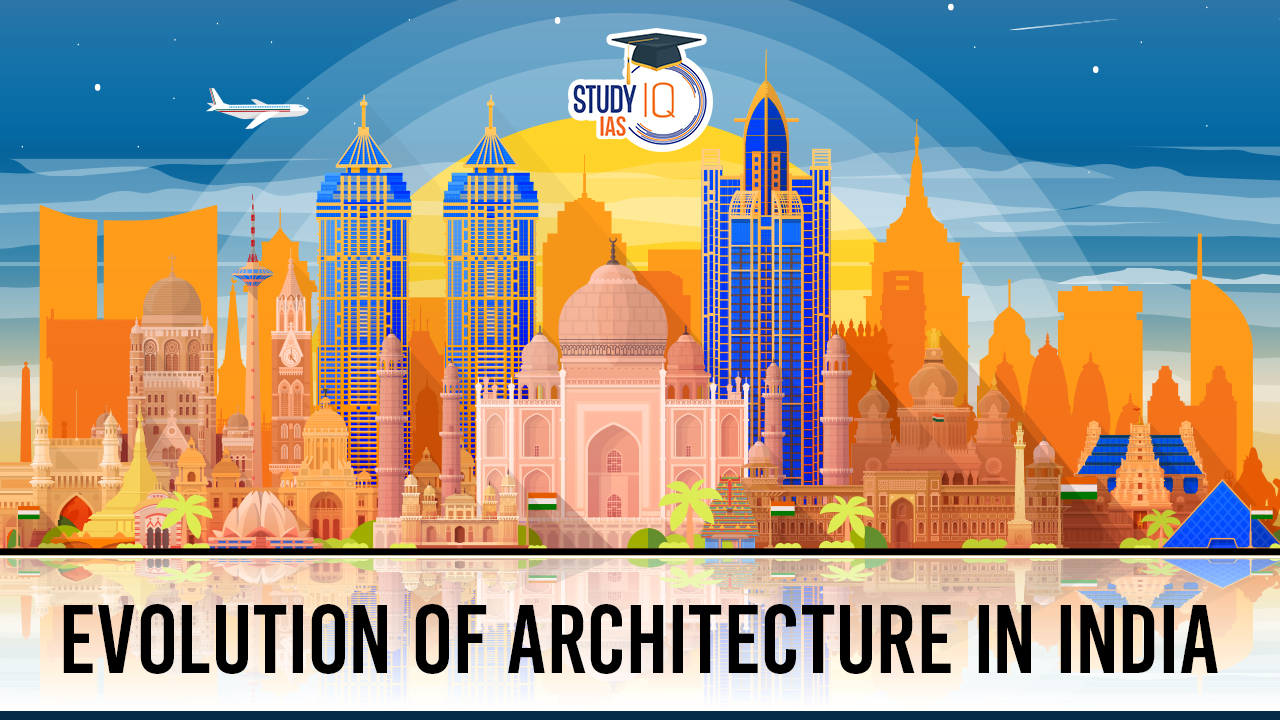Table of Contents
The evolution of Indian architecture spans over 4500 years, commencing with the Indus Valley Civilization around 2600 BC. Notable features include astute drainage systems, mud-bricked structures, and stone figurines. The Maurya Empire introduced impressive rock-cut architecture, notably Buddhist monasteries with wood arches and geometric cut-outs. Gupta Architecture marked the emergence of Hindu temple design, featuring detailed paintings and divine idols.
Islamic and Mughal styles integrated Persian, Central Asian, and Ottoman influences, seen in scalloped arches, domes, and contrasting colors. Regional styles like Rajput, Sikh, and Maratha showcased diverse influences, while colonial architecture displayed British Gothic and Art Deco influences in landmarks like the Gateway of India and Chhatrapati Shivaji Maharaj Terminus.
We’re now on WhatsApp. Click to Join
Evolution of Architecture in India
The architectural evolution in India spans centuries, shaped by changing trends and cultural influences. India’s ancient civilization, one of the world’s oldest, reflects distinctive architectural styles. The earliest examples from the Indus Valley Civilization (2600-1700 BC) feature brick construction, seal carvings, and multistoried buildings with advanced drainage systems. The Buddhist era introduced stupas, influenced by King Asoka in the third century BC, emphasizing functionality over grandeur.
The early modern era saw the refinement of cave temples like Mahabalipuram and Kanchipuram, adorned with intricate ornamentation. Rulers sought to manifest power and preserve national identity against Muslim invasions. The influence of Muslim culture between the 16th and 19th centuries led to the creation of mosques and fortresses, exemplified by the iconic Taj Mahal, blending Islamic and Indian architectural elements.
Subsequent Western colonization introduced Christian churches and European-style cities. Contemporary architects now blend various styles, reflecting India’s diverse history. Today, Indian cities showcase a fusion of architectural influences, providing a tangible timeline of the nation’s rich history and cultural amalgamation.
History of Architecture in India
| Period | Key Features | Notable Structures |
| Indus Valley Civilization (3300–1300 BCE) | Advanced urban planning with baked brick structures. – Well-organized streets and drainage systems. | – Cities of Harappa and Mohenjo-Daro. |
| Vedic Period (1500–500 BCE) | Simple, often wooden structures for religious rituals. | – Early Vedic settlements. |
| Maurya Empire (322–185 BCE) | Construction of the Great Stupa at Sanchi. – Ashoka Pillars with inscribed edicts. | – Great Stupa at Sanchi. – Ashoka Pillars. |
| Satavahana and Kushan Period (1st century BCE – 3rd century CE) | Emergence of rock-cut architecture. – Elaborate caves at Ajanta and Ellora. | – Caves at Ajanta and Ellora. |
| Gupta Empire (4th–6th centuries) | Golden age of Indian art and architecture. – Temples with a blend of sculpture and structure. | Dashavatara Temple at Deogarh. |
| Medieval Period (7th–17th centuries) | Chalukya, Rashtrakuta, and Pallava temple architecture. – Islamic architecture introduced. Vijayanagara Empire in the south. | Shore Temple at Mahabalipuram. Qutub Minar. – Virupaksha Temple. |
| Mughal Empire (16th–19th centuries) | Fusion of Persian, Timurid, and Indian styles. Monumental structures in red sandstone and marble. | Taj Mahal. – Red Fort. – Jama Masjid. |
| Colonial Period (17th–20th centuries) | European colonial influences. – Indo-Saracenic architecture. | Victoria Memorial. – Gateway of India. |
| Post-Independence Period (20th century–present) | Emergence of modern Indian architecture. – Integration of tradition with contemporary design. | Lotus Temple. – Buildings by architects like Charles Correa and B.V. Doshi. |
| Contemporary Period | Sustainable design and eco-friendly architecture. – Fusion of tradition and modernity. | Contemporary skyscrapers. |
Indus Valley Civilization (circa 3300–1300 BCE)
- The Indus Valley Civilization, one of the world’s oldest urban cultures, displayed advanced city planning. Cities like Harappa and Mohenjo-Daro featured well-organized streets, drainage systems, and multi-story buildings made of baked bricks.
- The architecture was primarily utilitarian, with a focus on efficient city infrastructure.
Vedic Period (1500–500 BCE)
- The Vedic period saw the construction of simple structures, often made of wood, for religious rituals and gatherings.
- Architectural focus was on functionality, reflecting the nomadic lifestyle of the early Vedic people.
Maurya Empire (322–185 BCE)
- The Mauryan Empire, under Ashoka, left a significant architectural legacy. The Great Stupa at Sanchi, with its hemispherical dome and intricate gateways, is a key example.
- Ashoka Pillars, inscribed with edicts, showcased the use of stone as a medium for royal proclamations.
Satavahana and Kushan Period (1st century BCE – 3rd century CE)
- The Satavahanas and Kushans contributed to rock-cut architecture. Caves at Ajanta and Ellora featured elaborately carved facades and interiors, displaying religious themes through sculptures and paintings.
Gupta Empire (4th–6th centuries)
- The Gupta period is often considered the “Golden Age” of Indian art and architecture. Temples, such as those at Deogarh and Dashavatara Temple at Deogarh, began to emerge.
- Gupta architecture displayed a harmonious blend of sculpture and structural design.
Medieval Period (7th–17th centuries)
- Early Medieval Period:
- The Chalukyas, Rashtrakutas, and Pallavas contributed to temple architecture in the south. The Shore Temple at Mahabalipuram is an excellent example.
- Islamic Architecture:
- The Delhi Sultanate and later the Mughal Empire brought Islamic architectural styles. The Qutub Minar and the complex at Fatehpur Sikri showcase intricate carvings and the use of red sandstone.
- Vijayanagara Empire:
- In the south, the Vijayanagara Empire erected grand temples like the Virupaksha and Vittala temples in Hampi, showcasing a unique Dravidian style.
Mughal Empire (16th–19th centuries)
- Mughal architecture, a fusion of Persian, Timurid, and Indian styles, reached its zenith. The Taj Mahal, a masterpiece of symmetry and white marble, is a symbol of Mughal architectural splendor.
- Other notable structures include the Red Fort in Delhi, Jama Masjid, and Humayun’s Tomb.
Colonial Period (17th–20th centuries)
- European colonial powers, especially the British, left an imprint on Indian architecture. The Victoria Memorial in Kolkata, featuring a blend of British and Mughal architecture, is a prime example.
- Indo-Saracenic architecture emerged, combining Indian, Islamic, and European elements.
Post-Independence Period (20th century–present)
- Modern Indian architects like Charles Correa and B.V. Doshi contributed to the evolution of a unique Indian modernist style.
- Cities saw the development of skyscrapers, and contemporary architects increasingly blended traditional elements with innovative designs.
Contemporary Period
- Contemporary Indian architecture continues to evolve with a focus on sustainability, eco-friendly designs, and a balance between tradition and modernity.
- Notable structures include the Lotus Temple in Delhi, reflecting organic forms and environmental consciousness.
Evolution of Architecture in India UPSC
Indian architecture, spanning 4500 years, reflects a rich tapestry of styles. The ancient Indus Valley Civilization showcased advanced urban planning, while the Maurya Empire introduced rock-cut marvels like the Great Stupa. Gupta Architecture marked the emergence of Hindu temples, blending sculpture and structure. Medieval periods featured diverse styles, from Chalukyan temples to Mughal grandeur like the Taj Mahal. Colonial influences brought Indo-Saracenic marvels like the Gateway of India. Post-independence, architects like Correa and Doshi shaped modern designs. Today, contemporary Indian architecture embraces sustainability, seen in the Lotus Temple and skyscrapers, encapsulating a dynamic journey through time and culture.


 Bonalu Festival 2025: Date, History, Rit...
Bonalu Festival 2025: Date, History, Rit...
 Puri Jagannath Rath Yatra 2025, History,...
Puri Jagannath Rath Yatra 2025, History,...
 Ambubachi Mela 2025: Dates, Rituals, Sig...
Ambubachi Mela 2025: Dates, Rituals, Sig...





















